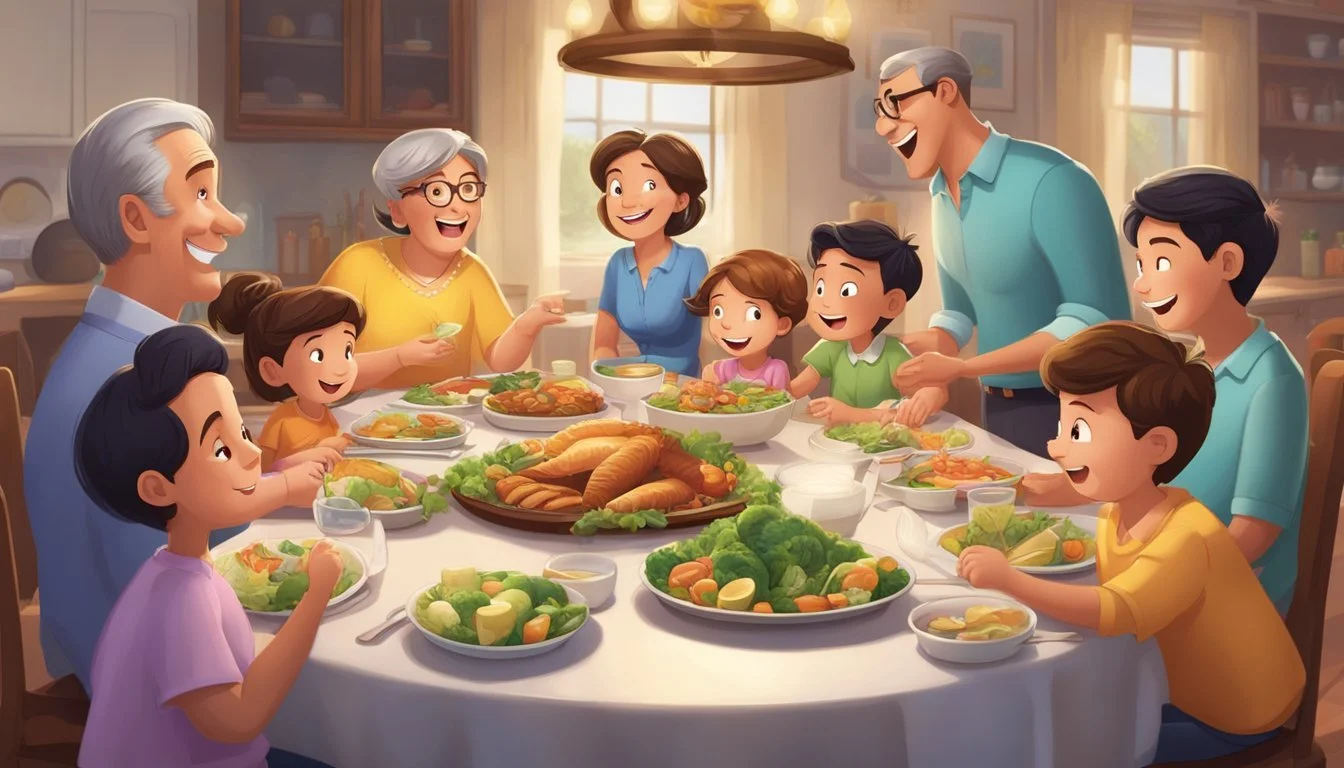Unlock the Laughs: Dive into the Hilarious Family Guy Personality Types!
Family Guy, the animated sitcom created by Seth MacFarlane, has entertained audiences since 1999 with its quirky characters and irreverent humor. The Griffin family and their eccentric friends have become iconic figures in popular culture, each with distinct personalities that resonate with viewers.
The MBTI (Myers-Briggs Type Indicator) provides a fascinating lens through which to analyze the diverse cast of Family Guy. This personality assessment tool categorizes individuals into 16 different types, offering insights into their behaviors, motivations, and decision-making processes. By examining characters like Peter, Lois, Stewie, and Brian through this framework, fans can gain a deeper understanding of what makes these animated personalities tick.
Exploring the MBTI types of Family Guy characters adds a new dimension to the show's appeal. It allows viewers to connect with their favorite characters on a psychological level and perhaps even recognize aspects of themselves in the Griffin family dynamics. This analysis also sheds light on the clever character development employed by the show's creators, showcasing the depth behind the comedy.
The Essence of Family Guy Characters
Family Guy's diverse cast embodies distinct personality types that drive the show's humor and storylines. Character development and family dynamics play crucial roles in shaping their interactions and growth throughout the series.
Personality Types in a Nutshell
Peter Griffin, the family patriarch, exemplifies the ESFP personality type. He lives in the moment, embraces spontaneity, and often acts on impulse rather than logic. His wife, Lois, exhibits traits of an ENFJ - caring, nurturing, and possessing a cunning edge to her personality.
Stewie, the precocious baby, aligns with the INTJ type. His intelligence, scheming nature, and long-term planning set him apart from typical infants. Meg, often the family outcast, may represent an ISFJ - introverted, sensitive, and seeking acceptance.
Chris, the middle child, displays characteristics of an ENFP. He's imaginative, easily distracted, and generally optimistic. Brian, the family dog, embodies an ENTP personality - witty, intellectual, and often challenging social norms.
Impact of Character Development
Over the series' run, Family Guy characters have undergone subtle yet significant changes. Peter's childish antics have become more extreme, highlighting his ESFP traits of sensation-seeking and living in the present.
Lois has shown increased complexity, with her ENFJ nature allowing for both nurturing moments and occasional ruthless behavior. Stewie's character arc has been particularly notable, evolving from a matricidal infant to a more nuanced individual.
Meg's development often revolves around her struggles for acceptance, reinforcing her potential ISFJ tendencies. Chris remains relatively consistent, with his ENFP-like qualities providing a steady source of offbeat humor.
Role of Family Dynamics
The Griffin family's interactions form the core of Family Guy's narrative. Peter's impulsive ESFP behavior frequently clashes with Lois's more grounded ENFJ approach, creating both conflict and comedic situations.
Stewie's INTJ-like plotting often involves manipulating family members, particularly Brian. Their intellectual sparring matches highlight the interplay between different personality types within the household.
Meg's position as the family scapegoat influences her relationships with other characters. Her potential ISFJ traits of seeking harmony clash with the family's often chaotic nature.
Chris's ENFP-like openness to new experiences sometimes leads to unexpected alliances within the family, particularly with his father Peter. These dynamics showcase how diverse personality types can coexist within a single family unit.
Main Characters' MBTI Profiles
Family Guy's main characters display distinct personality types that contribute to the show's dynamic interactions and comedic situations. Their MBTI profiles offer insight into their motivations and behaviors.
Peter Griffin
Peter Griffin embodies the ENTP personality type. As an Extroverted, Intuitive, Thinking, and Perceiving individual, Peter thrives on new experiences and ideas. His quick wit and love for debate often lead to outlandish schemes and impulsive decisions.
Peter's Ne (Extraverted Intuition) fuels his creativity, allowing him to generate unconventional solutions to problems. However, his Ti (Introverted Thinking) sometimes struggles to filter these ideas, resulting in chaotic outcomes.
His enthusiastic nature and ability to adapt to new situations make him the center of attention in social gatherings. Peter's disregard for rules and traditions often clashes with societal norms, leading to humorous and sometimes problematic scenarios.
Lois Griffin
Lois Griffin exhibits traits consistent with the ESFJ personality type. As an Extroverted, Sensing, Feeling, and Judging individual, Lois prioritizes harmony and structure within her family and community.
Her dominant Fe (Extraverted Feeling) manifests in her desire to care for others and maintain social connections. Lois often acts as the voice of reason in the Griffin household, balancing Peter's impulsiveness with practicality.
Lois's Si (Introverted Sensing) values tradition and routine, evident in her efforts to uphold family values. Her nurturing nature extends beyond her immediate family, as she frequently engages in community activities and social causes.
Chris Griffin
Chris Griffin aligns with the ISFP personality type. As an Introverted, Sensing, Feeling, and Perceiving individual, Chris approaches life with a laid-back and artistic mindset.
His dominant Fi (Introverted Feeling) guides his personal values and emotions, often leading to unique perspectives and creative expressions. Chris's Se (Extraverted Sensing) allows him to live in the moment and appreciate sensory experiences.
While generally easygoing, Chris can be stubborn when his values are challenged. His artistic inclinations manifest in various forms, from drawing to music, reflecting his ISFP tendency to express emotions through creative outlets.
Meg Griffin
Meg Griffin displays characteristics of the ISFJ personality type. As an Introverted, Sensing, Feeling, and Judging individual, Meg values stability and seeks acceptance from others.
Her dominant Si (Introverted Sensing) makes her detail-oriented and respectful of traditions. Meg's auxiliary Fe (Extraverted Feeling) drives her desire to please others and fit in, often leading to frustration when her efforts go unnoticed.
Despite frequent mistreatment, Meg's ISFJ traits of loyalty and perseverance shine through. Her nurturing nature and willingness to help others, even when unappreciated, reflect her personality type's caring qualities.
Stewie
Stewie Griffin exhibits traits of the INTP personality type. As an Introverted, Intuitive, Thinking, and Perceiving individual, Stewie possesses a brilliant and analytical mind beyond his years.
His dominant Ti (Introverted Thinking) fuels his quest for knowledge and understanding of complex concepts. Stewie's auxiliary Ne (Extraverted Intuition) enables him to generate innovative ideas and inventions.
Stewie's intellect often clashes with his physical limitations as a toddler, creating humorous situations. His INTP characteristics manifest in his sarcastic wit, strategic planning, and occasional struggle with emotional expression.
Brian
Brian Griffin aligns with the INTJ personality type. As an Introverted, Intuitive, Thinking, and Judging individual, Brian approaches life with a strategic and analytical mindset.
His dominant Ni (Introverted Intuition) allows him to see underlying patterns and envision long-term outcomes. Brian's auxiliary Te (Extraverted Thinking) drives his desire for efficiency and logical problem-solving.
Brian's INTJ traits are evident in his intellectual pursuits, cynical humor, and occasional arrogance. His strong opinions and perfectionist tendencies sometimes create tension with other family members, particularly Peter.
Supporting Characters and Their Personalities
Family Guy's supporting cast features distinct personalities that add depth and humor to the show. These characters play crucial roles in the Griffin family's adventures and mishaps.
Glenn Quagmire
Glenn Quagmire, Peter's eccentric neighbor, is an ESTP personality type. His impulsive nature and love for excitement drive many of his actions. Quagmire's charm and quick wit often get him into and out of trouble.
As a pilot, Quagmire showcases the ESTP's adaptability and skill in high-pressure situations. His catchphrase "Giggity" exemplifies his playful and often inappropriate sense of humor.
Quagmire's personality is marked by:
Spontaneity
Resourcefulness
Sociability
Risk-taking behavior
Despite his flaws, Quagmire can be a loyal friend to Peter and the gang when needed.
Joe Swanson
Joe Swanson, the determined police officer and neighbor to the Griffins, exhibits traits of an ISTJ personality type. His strong sense of duty and adherence to rules guide his actions both on and off the job.
Joe's personality is characterized by:
Reliability
Practicality
Attention to detail
Commitment to justice
As a paraplegic, Joe demonstrates remarkable resilience and determination. His no-nonsense attitude often serves as a counterpoint to Peter's antics.
Joe's ISTJ traits shine through in his methodical approach to police work and his dedication to his family and community.
Cleveland Brown
Cleveland Brown, Peter's mild-mannered friend, displays characteristics of an ENFP personality type. His easygoing nature and optimism make him a likable character in the Family Guy universe.
Key aspects of Cleveland's personality include:
Warmth and friendliness
Creativity
Adaptability
Enthusiasm
Cleveland's ENFP traits are evident in his ability to see the best in others and his willingness to embark on new adventures. His laid-back demeanor often provides a calming presence among the chaotic events in Quahog.
As a deli owner and later a cable installer, Cleveland showcases the ENFP's versatility and people-oriented approach to life.
Personality Theories Explored
Personality theories provide frameworks for understanding individual differences in behavior, thought patterns, and emotions. Two popular systems for categorizing personality types are the Myers-Briggs Type Indicator (MBTI) and the Enneagram.
MBTI Fundamentals
The MBTI is based on Carl Jung's theory of psychological types. It classifies individuals into 16 personality types using four dichotomies:
Extraversion (E) vs. Introversion (I)
Sensing (S) vs. Intuition (N)
Thinking (T) vs. Feeling (F)
Judging (J) vs. Perceiving (P)
Each type is represented by a four-letter code, such as ENFP or ISTJ. These combinations describe how people prefer to interact with the world, process information, make decisions, and structure their lives.
MBTI types can offer insights into characters' motivations and behaviors in Family Guy. For example, Peter Griffin might be classified as an ESTP (Extraverted, Sensing, Thinking, Perceiving) due to his impulsive nature and focus on immediate experiences.
Enneagram Types
The Enneagram system identifies nine distinct personality types, each driven by core motivations and fears:
The Perfectionist
The Helper
The Achiever
The Individualist
The Investigator
The Loyalist
The Enthusiast
The Challenger
The Peacemaker
These types are interconnected on a circular diagram, with each type relating to others in specific ways. Enneagram theory suggests that people have one dominant type but can exhibit traits of other types.
In Family Guy, characters might align with different Enneagram types. Lois Griffin could be seen as a Type 2 (The Helper) due to her nurturing nature, while Stewie might embody aspects of Type 3 (The Achiever) in his quest for world domination.
Setting and Cultural Impact
Family Guy's fictional setting of Quahog, Rhode Island provides a backdrop for the show's satirical take on American culture. The series, created by Seth MacFarlane, has left an indelible mark on popular entertainment since its debut.
Quahog's Influence on Character Dynamics
Quahog serves as more than just a backdrop for Family Guy's antics. This fictional Rhode Island town shapes the personalities and interactions of its quirky residents. Peter Griffin's job at the Pawtucket Brewery reflects the area's industrial heritage. The Drunken Clam bar acts as a central meeting place, influencing social dynamics.
Quahog's small-town atmosphere allows for recurring characters to develop distinct personalities. Mayor Adam West's eccentric leadership and the meddling of nosy neighbor Herbert add layers to the Griffin family's daily lives. The town's layout, from Spooner Street to James Woods High School, provides familiar settings for the characters' misadventures.
Family Guy's Role in Pop Culture
Seth MacFarlane's animated sitcom has become a cultural touchstone since its 1999 debut. The show's irreverent humor and pop culture references have resonated with audiences worldwide. Family Guy's cutaway gags and non-sequiturs have influenced comedy styles in other animated series.
The Griffin family members have become recognizable icons. Stewie's diabolical plans and Brian's literary aspirations are frequently referenced in media. Family Guy's willingness to tackle controversial topics has sparked debates about the limits of satire.
The show's impact extends beyond television. Merchandise, video games, and even a spin-off series (The Cleveland Show) have expanded its reach. Family Guy's longevity and cultural relevance have cemented its place in the pantheon of influential animated sitcoms.
Analyzing Character Interactions
Family Guy's characters exhibit distinct personality types that shape their relationships and interactions. These dynamics drive much of the show's humor and plot development.
Friendships and Conflicts
Peter Griffin, an ESFP, forms spontaneous friendships with his neighbors and coworkers. His outgoing nature leads to both hilarious misadventures and frequent conflicts. Peter's impulsiveness often clashes with his wife Lois's more practical ESTP approach.
Stewie, the family's precocious toddler, displays INTJ traits in earlier seasons. His intellectual pursuits and scheming create an unlikely bond with the family dog, Brian. This friendship balances Stewie's calculating nature with Brian's more laid-back ISFP personality.
Cleveland Brown, an ISTP, maintains a steady friendship with Peter despite their contrasting personalities. Their relationship showcases how different types can complement each other.
Romantic Relationships and Family Bonds
Peter and Lois's marriage demonstrates the interplay between ESFP and ESTP types. Their shared love of excitement keeps their relationship dynamic, but Lois's practicality often tempers Peter's wilder impulses.
Chris Griffin, another ESFP like his father, struggles to connect with his family due to his slower wit. His relationship with Peter highlights how similar personality types can still face challenges in communication.
Meg, often overlooked, forms tenuous bonds with her family members. Her interactions reveal the complexities of family dynamics when one member doesn't quite fit the mold of their extroverted relatives.
Comparison to Other Animated Sitcoms
Family Guy's unique approach to character personalities sets it apart from other animated sitcoms. The show's diverse cast exhibits a wide range of MBTI types, creating complex dynamics and memorable interactions.
Personality Types Across Genres
Animated sitcoms often feature distinct personality archetypes. The Simpsons, for example, portrays Homer as an ESFP, while Lisa embodies an INFJ. South Park's characters span various MBTI types, with Cartman as an unhealthy ENTJ and Kyle as an INFJ.
Family Guy's characters showcase a broader spectrum of personalities. Peter Griffin, an ESFP, shares traits with Homer Simpson but exhibits more extreme behavior. Stewie, an ENTJ child prodigy, stands out as a unique creation in the genre.
Unique Traits of Family Guy's Approach
Family Guy distinguishes itself through its unconventional character development. The show frequently subverts expectations by giving seemingly one-dimensional characters surprising depth.
Brian, the family dog, presents as an ENTP with human-like qualities. This anthropomorphic approach allows for more complex interactions and storylines. Lois Griffin, an ESFJ, balances the family dynamic with her practical nature.
The show's side characters often display exaggerated MBTI traits. Quagmire, an extreme ESTP, and Mayor Adam West, an eccentric INFP, contribute to the show's diverse personality landscape. This variety of character types enables Family Guy to explore a wide range of comedic situations and social commentary.






